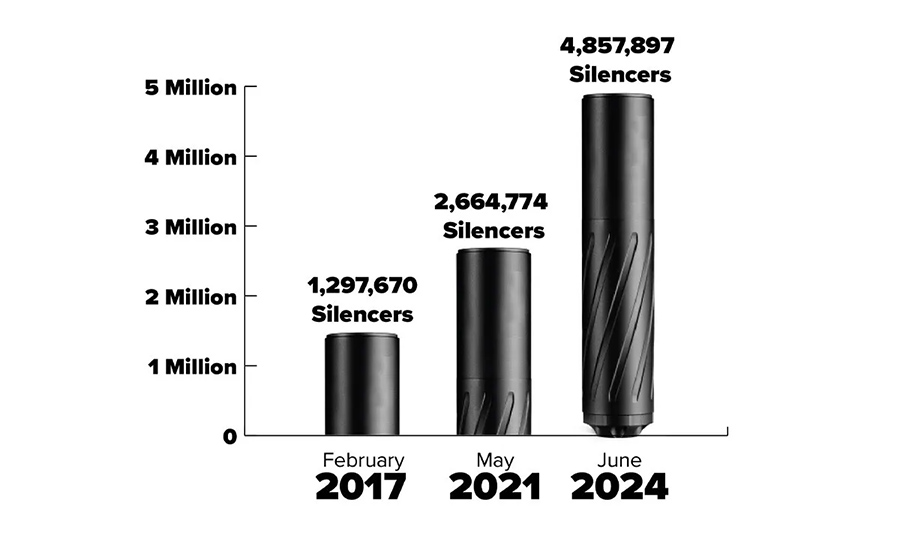
Shooting suppressed is as normalized among the shooting and hunting community as TikTok is with Gen Z. What was once a rarity as recently as a decade ago is now a normal occurrence with shooters using suppressor-equipped firearms at local ranges and hunting camps.
What is the process to legally acquire a suppressor or silencer? The oversimplified version is that you have to legally buy one from a retailer and register it. The process is mostly straightforward, but it requires a $200 transfer tax and a significant processing wait time. That’s been the procedure since the National Firearms Act (NFA) was enacted in 1934.
For many years, the expectation was to “buy it and forget it.” Customers were unlikely to physically take possession of their paid-in-full item for several months or as much as a year. The Bureau of Alcohol, Tobacco, Firearms and Explosives (ATF) has received exponentially more Form 4s for silencers as their popularity has grown. Through the combined efforts of NSSF, the firearm industry, and ATF, however, the process has dramatically improved beyond anyone’s expectations.
Record Ownership
Today, the ATF is processing suppressor applications in not only record time but in some instances the same day. The barrier from drawn out wait times is gone and it’s convincing shooters and hunters to purchase a suppressor who had previously dreaded the process and the delay in taking possession of their gear. As a result, silencer registration metrics are off the chart.
The now discontinued ATF Firearms Commerce in the United States report displayed the number of silencers that were registered in each state. The May 2021 edition reported 2,664,774 silencers in the U.S., more than doubling the 1.3 million silencers disclosed by the Department of Justice (DOJ) for 2017.
In a recent Freedom of Information Act request, NSSF received from ATF the additional number of silencers registered from May 2021 to July 2024. An incredible 2,193,123 more suppressors are now protecting the hearing of hunters and shooters. That means a whopping 4.86 million silencers and counting are now in the possession of law-abiding Americans.

To review, the NFA started requiring the registration of silencers in 1934 and up to May 2021 had 2.66 million suppressors on the books. Now American gun owners are on track to exceed 87 years of registered silencers in just the latest three years.
What’s Next?
The NSSF-supported Hearing Protection Act, H.R. 152 introduced by U.S. Rep. Jeff Duncan (R-S.C.) and S. 401 introduced by U.S. Sen. Mike Crapo (R-Idaho), would remove silencers from the NFA, eliminate the $200 tax stamp and allow firearm owners to purchase a silencer, like any other firearm, after an FBI National Instant Criminal Background Check System (NICS) verification. This would allow more gun owners to more easily acquire a suppressor and safely reduce the report of their firearms to hearing-safe levels without the additional $200 tax. Suppressors are already legal to own in 42 states and 41 states allow them for hunting.
The NSSF-supported Tax Stamp Revenue Transfer for Wildlife and Recreation Act, H.R. 6352 introduced by Rep. Blake Moore (R-Utah), offers an alternative approach. This bill would reallocate the funding generated from suppressor tax stamps. Fifteen percent of the revenue would go to the ATF’s NFA division to fund and further improve the processing of Form 4s. The remaining 85 percent would go to U.S. Fish and Wildlife Service (USFWS) and be split between the Pittman-Robertson Wildlife Restoration Trust Fund and a portion dedicated to recreational shooting range development.
Gun ownership has skyrocketed over the past several years, including more than 22.3 million new first-time gun owners since 2020. Likewise, as millions of Americans have become more knowledgeable and familiar with firearms, they’ve also become more familiar with what a suppressor is and isn’t. Suppressors, or “silencers” as they are called in the law, are nothing like the way they are characterized in Hollywood films. They do not silence the firearm’s report. They act like a muffler to reduce the sound level.
Firearm legislation is always going to divide people and face gridlock in Washington, D.C., and in state capitals across the country. No matter how logical it would be to streamline the process of purchasing a firearm suppressor or better allocate the tax stamp revenue, getting Congress to act will be a Herculean effort.
As it has with gun ownership more broadly, the tide has turned on suppressor ownership, too.

When Trump wins, he’s going to take a wrecking ball to all these over-reaching agencies and restore our Constitutional rights! Ah, who am I kidding? sigh… we get the gov’t we deserve…
Between the simplification of the NFA regs several years ago (e.g., eliminating the old requirement of a permission letter from your local police chief or sheriff) and the implementation of e-forms, wait times have indeed shrunk. For example, in 2016, my wait time for two cans I bought through a trust was about 6 months. A couple of years later, Form 1’ing an SBR through that same trust took about four months. But about a month ago, I got a couple of cans through a trust, and the wait was only 44 days (trusts still take a bit longer, but apparently ATF is about to implement procedures that will decrease it dramatically if you are using trust documents they have reviewed before).
When I picked up my cans, the guy in line in front of me at Capitol Armory said he’d bought his can the day before on his lunch break (buying it in his name), and had gotten his tax stamp approved in less than 24 hours!
If you want to get a can (and you should), now is a great time to do so. Go through Silencer Shop or Capitol Armory (both of which have the process automated and down pat) and it’s very easy.